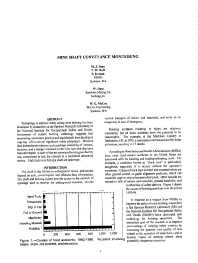Mining Publication: Mine Shaft Conveyance Monitoring
Original creation date: October 2000
Monitoring conveyance position and wire rope load directly from the skip or cage top offers several significant safety and production advantages. The Spokane Research Laboratory of the National Institute for Occupational Safety and Health (NIOSH) developed a shaft conveyance monitoring system (SCMS). This system consists of position and guide-displacement sensors, a maintenance-free battery power supply and a new sensor, which is mounted on the wire rope with a Crosby Clip, to measure hoist-rope tension. A radio data link transmits sensor output to the hoistroom. A state-of-the-art automated hoisting test facility was also constructed to test the concept in a controlled laboratory setting. Field tests in full-size shafts are now underway.
Authors: MJ Beus, TM Ruff, SR Iverson, W Hasz, WG McCoy
See Also
- Development of a Mine Hoist and Ore Pass Research Facility
- A Guidance Sensor for Continuous Mine Haulage
- A Model for the Structure of Round-Strand Wire Ropes
- A PC-Based Monitoring System for Mine Hoisting
- Pillar Strength and Design Methodology for Stone Mines
- Rock Mechanics Study of Shaft Stability and Pillar Mining, Homestake Mine, Lead, SD (In Three Parts): 2. Mine Measurements and Confirmation of Premining Results
- Rock Mechanics Study of Shaft Stability and Pillar Mining, Homestake Mine, Lead, SD (In Three Parts): 3. Geomechanical Monitoring and Modeling Using UTAH3
- Safer Mine Hoisting With Conveyance Position and Load Monitoring
- Solutions to Prevent Materials-Handling Injuries in Underground Coal Mines
- Technology News 458 - Development of a Research Facility to Improve Mine Hoisting and Ore Pass Safety
- Content source: National Institute for Occupational Safety and Health, Mining Program


 ShareCompartir
ShareCompartir
